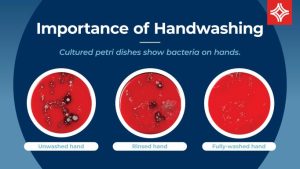Proper Hand-Washing: It Takes Time
 That quick wash of a few seconds with soap and water may not help as much as you think – as these three photos reveal. Each photo shows the bacteria growing in a Petri dish after a volunteer pressed his hand into a layer of gel in the dish.
That quick wash of a few seconds with soap and water may not help as much as you think – as these three photos reveal. Each photo shows the bacteria growing in a Petri dish after a volunteer pressed his hand into a layer of gel in the dish.
- First dish = germs found on an unwashed hand.
- Second dish = shows the bacteria growing on the same hand after washing for a few seconds with soap and water. These two dishes show remarkably similar amounts of bacteria.
- Third dish = same volunteer’s hand after he washed and scrubbed his hands for 15 seconds before rinsing. This plate uncovers vastly fewer germs.
The photos reinforce the recommendations of the Centers for Disease Control and Prevention (CDC), which advises washing your hands often with soap and water as an everyday action to stop the spread of germs.
Flu season typically runs from October to March and starts to pick up steam in December as chillier weather keeps people inside and in closer quarters and as family and holiday gatherings increase. However, germs and infections can run rampant year round and handwashing is a solid prevention strategy.
According to the CDC website, “many diseases and conditions are spread by not washing hands with soap and clean, running water.” And if no soap and water are available, you should use an alcohol-based hand sanitizer that contains at least 60-percent alcohol to clean your hands.
Related Articles
Wash Your Hands Properly: Use Water First